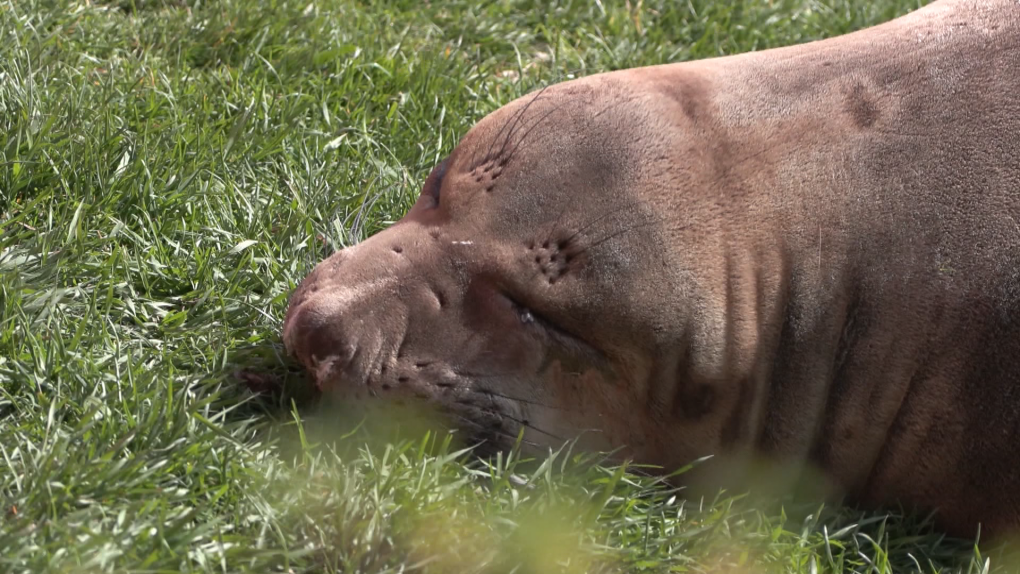Relocated seal returns to Greater Victoria after 'astonishing' 204-kilometre trek
A moulting seal who was relocated after drawing daily crowds of onlookers in Greater Victoria has made a surprise return – after what officials described as an "astonishing" six-day journey.
And while the unusual case of Emerson the elephant seal has delighted the public, Fisheries and Oceans Canada is growing increasingly worried the animal could harm one of his many fans.
Authorities said people have been approaching the juvenile seal to pet him or take selfies, in some cases encouraging young children to do the same.
"In one reported instance, a child was coaxed to touch their nose to his," the DFO said in a statement.
There have also been reports of unleashed dogs approaching Emerson and barking at him, sometimes at the owner's prompting.
Overall, the DFO said, reports of "harassment of Emerson have increased to concerning levels."
Relocation unsuccessful
Emerson has been spotted several times around the B.C. capital since spring 2023, including in the communities of Oak Bay and Sooke.
The animal has demonstrated a degree of comfort around people that officials warn could eventually lead to trouble – which prompted DFO staff to relocate Emerson to an undisclosed beach on northern Vancouver Island on April 5.
But Emerson made his way back – a trek that required travelling an average of 34 kilometres per day for six days, for a total distance of around 204 kilometres.
The DFO said its preference is now to allow Emerson to "complete his moulting process in the location he has chosen," but stressed that the public must help out by giving the animal his space.
 Emerson the elephant seal is seen in Oak Bay, B.C., prior to being relocated on April 5, 2024.
Emerson the elephant seal is seen in Oak Bay, B.C., prior to being relocated on April 5, 2024.
Potential danger
Concerns about wildlife conflicts with Emerson are only expected to increase as the seal grows. While he currently weighs an estimated 500 pounds, the DFO said he could eventually reach more than 4,000 pounds at maturity.
Even at his current size – weighing approximately as much as a male black bear – officials have warned he could pose a danger to people and pets.
"Emerson is a wild animal that could react aggressively if he feels threatened," the DFO said.
"The department is concerned that, if public disturbances of the elephant seal continue, someone will get hurt, or the animal will experience adverse health outcomes. The natural moulting process is highly taxing on the seal and any unnecessary expenditure of energy depletes its short-term health and could have long-term implications."
Seals can also carry a number of diseases that can spread to humans, such as seal pox.
Moulting process
The process of moulting takes several weeks and involves shedding all of a seal's fur, plus an underlying layer of skin.
While this is going on, the DFO said, Emerson can be expected to spend most of his time on land "dozing and lazily flipping sand onto (himself) to stay cool."
Moulting seals do not eat, according to officials, and can lose up to a quarter of their body weight.
The DFO noted that disturbing wildlife – whether they are moulting or not – can net fines of up to $100,000.
Anyone who spots someone harming or harassing a wild animal is asked to report it to the DFO Pacific Region's toll-free hotline at 1-800-465-4336.
CTVNews.ca Top Stories

Heavy snow, freezing rain warnings hit parts of Canada, expected to last throughout Monday
Significant snowfall and heavy rain hit parts of Canada on Sunday and the weather system is expected to continue into Monday morning and throughout the day.
BoC expected to lower interest rates again, with odds leaning toward larger cut
Financial markets and forecasters are betting on another jumbo interest rate cut from the Bank of Canada this week.
The Canada Post strike involving more than 55,000 has hit 25 days
The Canada Post strike involving more than 55,000 workers has hit 25 days.
Celebrities spotted at Taylor Swift's final Eras Tour performance in Vancouver
Taylor Swift fans from around the world gathered in Vancouver on Sunday to witness the final performance of her massively popular Eras Tour, including a few celebrities.
Government faces third Tory non-confidence vote ahead of potential fiscal hurdle
The Liberals are set to face a third Conservative non-confidence vote today, but the government is likely to survive with the support of the NDP.
Most Canadians view illegal immigrant border crossings as concern for U.S.: Nanos survey
More than 80 per cent of Canadians believe the flow of illegal immigrants from Canada to the U.S. is a concern, according to a new survey.
Jay-Z denies allegations he sexually assaulted a 13-year-old in 2000 with Sean 'Diddy' Combs
A woman who alleges she was sexually assaulted by Sean 'Diddy' Combs has amended her lawsuit to include allegations that she was also assaulted by Jay-Z at the same party.
Taylor Swift ends record-smashing Eras Tour in Vancouver, after glittering global run
Taylor Swift took the stage for the final time on her record-smashing Eras Tour, watched by tens of thousands of delirious fans in Vancouver's BC Place arena and by millions on livestreams around the world.
Syrian prime minister says government is still functioning but foreign and domestic challenges loom
Syria's prime minister said Monday that most cabinet ministers are still working from offices in Damascus after rebels entered the capital over the weekend and overthrew President Bashar Assad. Streams of refugees crossed in from neighboring countries, hoping for a more peaceful future.






























